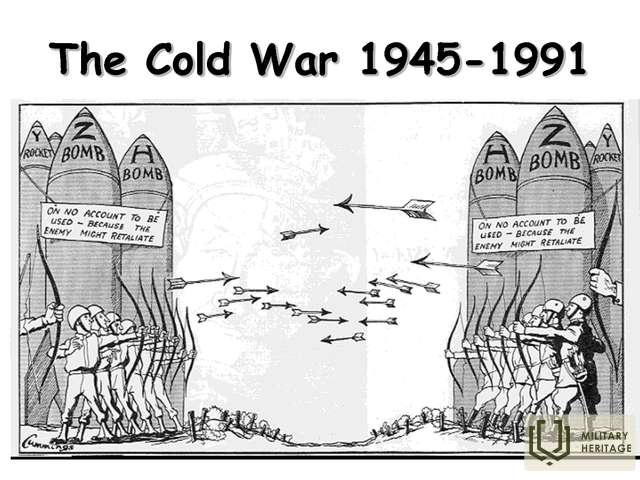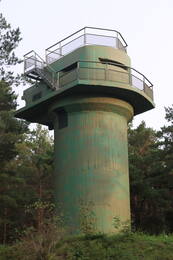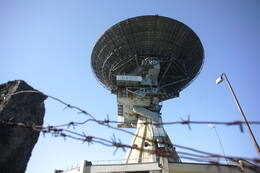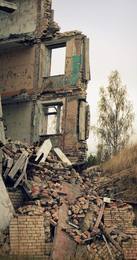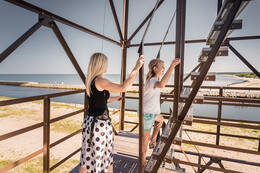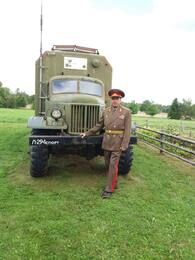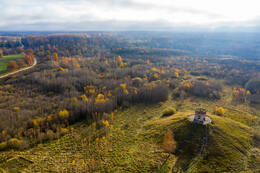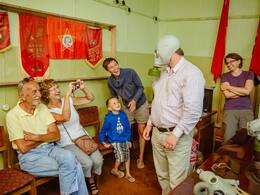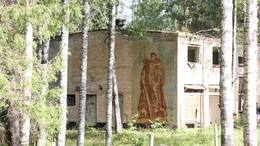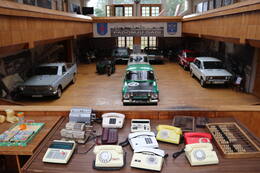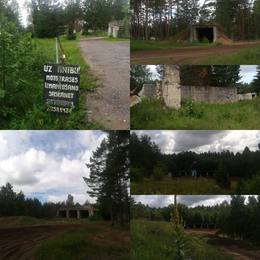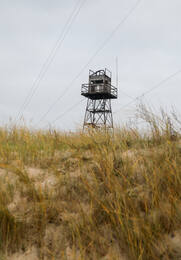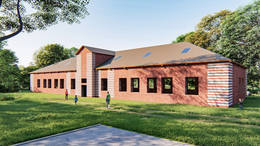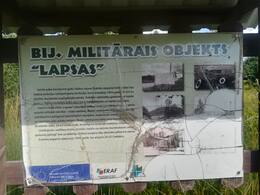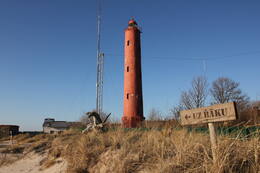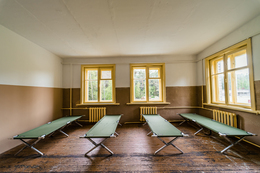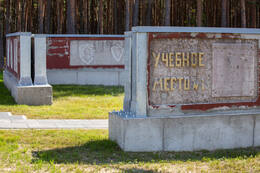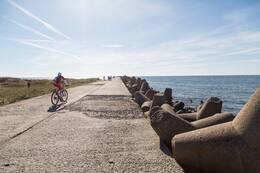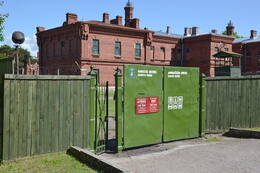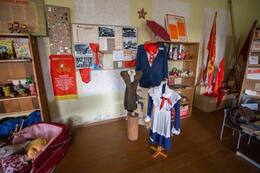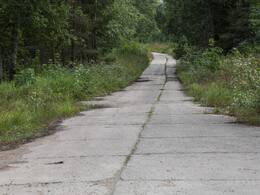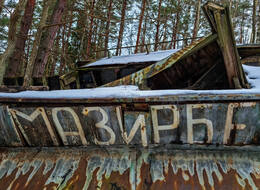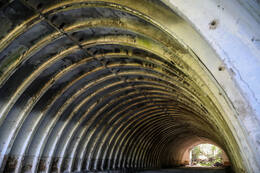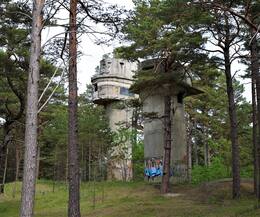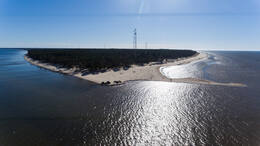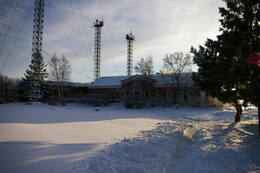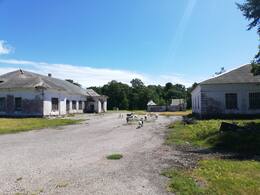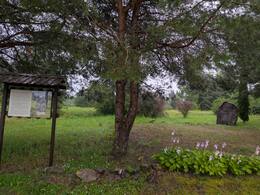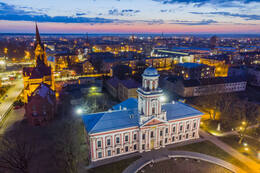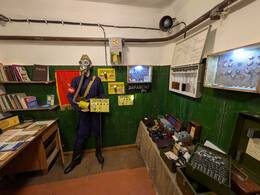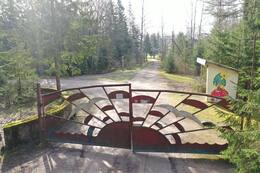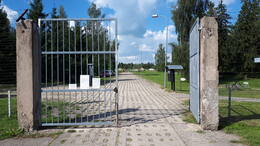Šaltasis karas
IV Sovietų okupacija, Atkurta Nepriklausomybė
Šaltasis karas (an. Cold War, vc. Kalter Krieg, fr. Guerre froide, kr. холодная война) – priešiška politinė ir ekonominė konfrontacija XX a. antroje pusėje tarp SSRS ir jos palydovinių šalių, viena vertus, ir Vakarų šalių, kita vertus.
Tai įvyko 1946 m. kovo 5 d., kai buvęs Didžiosios Britanijos ministras pirmininkas Winstonas Churchillis Fultone (JAV) sakytoje kalboje teigė, kad Europą dėl ideologinių prieštaravimų tarp sovietų okupuotos zonos ir likusios Europos skiria „geležinė uždanga“. Nuo tada terminas „geležinė uždanga“ buvo vartojamas kaip skiriamoji linija tarp SSRS ir Vakarų šalių įtakos sferos visame pasaulyje. JAV ir SSRS konkuravo tarpusavyje provokuodamos ar dalyvaudamos kariniuose konfliktuose skirtingose pasaulio dalyse, kurdamos satelitinius režimus, ieškodamos naujų sąjungininkų, konkuruodamos ekonomiškai ir politiškai bei keisdamosi kaltinimais, siekdamos padidinti savo įtaką mažindamos kitos pusės įtaką.
Ši konkurencija palaikė bendrą politinės destabilizacijos jausmą pasaulyje iki devintojo dešimtmečio pabaigos, kai SSRS ekonomika nebegalėjo konkuruoti ir žlugo.
Daugiau informacijos šaltinių
Kaip ir kodėl prasidėjo Šaltasis karas? / Straipsnis (lsm.lv)
Šaltasis karas – Vikipedija (wikipedia.org)
Susijusi laiko juosta
Susijusios vietos
Ventspilio 46-osios pakrantės gynybos baterijos ugnies korekcijos bokštas
Atkurtas 46-osios pakrančių apsaugos baterijos ugnies valdymo bokštas Ventspilyje yra Saulrietos gatvėje ir lankytojams prieinamas apžvalgos bokšto pavidalu. Šalia bokšto yra keturios artilerijos pabūklų pozicijos, ir tai vienintelė tokios geros būklės Antrojo pasaulinio karo pakrančių gynybos baterija Latvijoje. Lankytojai gali lipti bokšto laiptais į lauko apžvalgos aikštelę su vaizdu į jūrą. Šalia bokšto yra informacinis stendas su QR kodu. Naudodami QR kodą galite žiūrėti animaciją apie istorinius įvykius. Į bokštą veda nauja gatvė, didelė automobilių stovėjimo aikštelė ir medinis pėsčiųjų tiltas, einantis per šalia bokšto esančią saugomą gamtos teritoriją.
Šis karinis kompleksas buvo pastatytas 1939 m., žymint SSRS karinių bazių statybos Latvijoje pradžią. 46-oji pakrančių apsaugos baterija turėjo keturias pozicijas B-13 tipo pabūklams. Pirmąjį karinį mūšį ši baterija surengė 1941 m. birželio 24 d., kai Ventspilio uostą užpuolė vokiečių torpediniai kateriai, kurie baterijų ugnimi buvo atitraukti nuo Baltijos jūros krantų. Birželio 28 d. sovietų armija susprogdino pabūklus ir pasitraukė.
Žvaigždė - Irbenės kariniai pastatai
200 hektarų ploto teritorija kadaise buvo itin slapta karinė bazė, kurioje buvo įsikūręs 51429 karinis dalinys.
Buvęs sovietinės pasienio apsaugos stebėjimo bokštas Paviluostoje
Sovietinis pasienio apsaugos apžvalgos bokštas yra netoli Pietinio molo Paviluostoje. Buvęs sovietinis pasienio apsaugos apžvalgos bokštas, kuris buvo nenaudojamas nuo XX a. dešimtojo dešimtmečio pradžios, dabar tarnauja kaip apžvalgos aikštelė su 360 laipsnių kampu besisukančiu sausumos teleskopu. Iš jo atsiveria gražūs jūros ir laivų vaizdai, jį galima naudoti paukščių stebėjimui. Lipti į bokštą leidžiama tik vasaros sezonu dienos šviesoje. Kadangi bokšto laiptai yra gana statūs, lankytojai turėtų įvertinti savo sugebėjimus, sveikatą ir susijusią riziką. Apžvalgos bokštas ir apylinkės stebimos vaizdo kameromis. Žiemos sezonu bokštas lankytojams uždarytas.
Sovietų armijos automobilių kolekcija
Edgaras Kārklevalkas Dundagos rajone valdo svečių namus „Pūpoli“ ir jau daugiau nei 15 metų savo restauruotu sovietinės armijos sunkvežimiu GAZ-66 (iki 24 asmenų) ir UAZ-3151 (iki 6 asmenų) veda žmones į istorines ir edukacines keliones po šiaurinę Kuržemę (įskaitant buvusias karines teritorijas). Sovietinės armijos sunkvežimiai ir kita įranga eksponuojami aplink svečių namus esančioje teritorijoje.
Sovietų armijos apžvalgos bokštas (Karininkų kurganas)
„Karininkų kurganas“ yra mažiau nei už kilometro nuo Zvārdės bažnyčios griuvėsių. Kurganas sudarytas iš aplinkinių namų ir dvaro rūmų griuvėsių ir liekanų, kurios buvo suverstos buldozeriais. Ant kurgano pastatytas stebėjimo bokštas. Remiantis užrašu, dabartinis bokštas buvo pastatytas 1981 m. Bokštas buvo naudojamas bombų pataikymams registruoti. Mokomosiose bombose buvo sumažintas sprogstamosios medžiagos kiekis, todėl jų pataikymus reikėjo stebėti atidžiau. Nesprogusios bombos buvo nedelsiant neutralizuotos, tačiau ne visas pavyko rasti.
Šiandien čia galima pamatyti bokšto liekanas – plytų sienas. Kadangi užtvanka yra gana aukšta, giedrą dieną Mažeikiuose galima pamatyti net Lietuvos naftos perdirbimo gamyklą.
Slaptas sovietinis bunkeris Lygatnėje
Įsikūręs Lygatnės valsčiuje, Cėsių savivaldybėje, sovietinis slaptasis bunkeris yra 9 metrus žemiau Lygatnės reabilitacijos centro pastato ir gretimos teritorijos. Bunkeris atviras lankytojams ir siūlo ekskursijas su gidu, maitinimą bunkerio valgykloje, sovietinio stiliaus vakarėlius ir realybės žaidimą „Objektas X“. Bunkerio paskirtis buvo sudaryti minimalias būtinas sąlygas ilgalaikiam darbui Latvijos SSR Ministrų Tarybai, LTSR Komunistų tarybos vadovybei ir LTSR valstybinio planavimo komiteto vadovybei branduolinio karo grėsmės atveju. 2000 kvadratinių metrų ploto požeminis bunkeris buvo tvirčiausias autonominis statinys su visa reikalinga ir moderniausia tuo metu įranga, taip pat vienas strategiškai svarbiausių objektų sovietmečio Latvijoje branduolinio karo atveju. Teritorijoje yra saugoma požeminė darbo vieta (slėptuvė), sanatorijos tipo miegamasis blokas 250 žmonių, apsaugos patalpos ir 24 butų gyvenamasis namas aptarnaujančiam personalui. Visa autentiška požeminė įranga ir planai yra išsaugoti iki šių dienų. Svarbiausi objektai – autonominė elektrinė su dyzeliniais generatoriais ir kuro saugykla, oro valymo įranga su deguonies atsargomis, povandeninio laivo principu veikianti vandens tiekimo ir nuotekų sistema, telekomunikacijų įrenginys, galintis užtikrinti tiesioginį ryšį su Maskvos Kremliumi ir autonominį ryšį su visomis pagrindinėmis šalies tarnybomis, unikalus žemėlapis su istoriniais kolūkių pavadinimais, autentiška valgykla su tipiškais sovietmečio patiekalais, taip pat įvairūs sovietmečio atributai ir namų apyvokos daiktai.
Sovietų armijos raketų bazė Zeltiniuose
Buvusi sovietų armijos raketų bazė yra Medņukalnuose, Zeltinių valsčiuje, Alūksnės savivaldybėje. Ši branduolinių raketų bazė buvo ypač slaptas sovietų armijos karinis objektas, veikė Zeltiniuose, Alūksnės savivaldybėje, nuo 1961 iki 1989 m. Objekte buvo dislokuotos vidutinio nuotolio balistinės raketos P-12 (8K63) ir P12Y (8K63Y) su 4 paleidimo aikštelėmis. Jų skrydžio atstumas buvo 2200 kilometrų. Šiuo laikotarpiu armija spygliuota viela saugojo apie 300 ha plotą, esantį mažiau nei kilometro atstumu nuo nacionalinio regioninio greitkelio Sinole-Silakrogs P34. Gyvosios ir itin slaptos zonos išliko iki šių dienų. Betoniniai keliai veda į tuo metu nuo akių paslėptas vietas: angarus, paleidimo aikšteles ir slėptuves nuo bombų. Dešimčių hektarų plote išsidėstę įvairūs branduolinių raketų priežiūros ir aptarnavimo statiniai. Įrenginiai, tiekę autonominį elektros energijos, vandens ir šilumos tiekimą teritorijai, buvo sunaikinti pasitraukus kariuomenei. Kariuomenei pasitraukus, dalis įrangos buvo perduota vietos savivaldybei. Šiuo metu lankytojai gali apžiūrėti 20 ha buvusios raketinės bazės teritorijos, kurios pietvakarinė dalis yra turistų traukos objektas. Bazę aplankę turistai gali rinktis iš pagrindinės ekspozicijos apie raketinės bazės istoriją, esančios Zeltinių muziejuje, arba turistinio maršruto bazės teritorijoje. Draugų grupės iki 12 žmonių čia gali žaisti lazerinį žaidimą.
Aizkrauklės istorijos ir meno muziejaus ekspozicija „Sovietmetis“
Minint Latvijos šimtmetį, 2018 m. lapkritį Aizkrauklės seniūnijos kultūros namuose pradėjo veikti Aizkrauklės istorijos ir meno muziejaus ekspozicija „Sovietmetis“ – didžiausia ekspozicija Baltijos šalyse, skirta XX amžiaus (1950–1980 m.) kultūriniam ir istoriniam paveldui. Ekspozicija išdėstyta per tris aukštus ir užima 1060 m2 plotą. Joje pristatomi įvairūs gyvenimo sovietmečiu aspektai: buitis, darbas ir laisvalaikis, švietimas ir kultūra. Pirmajame aukšte eksponuojami sovietmečio automobiliai. Atskirai įrengta biblioteka – Raudonasis kampelis. Įvairialypė ekspozicija kviečia susipažinti su sovietmečio kasdienybe ir butų interjeru – baldais, buities reikmenimis, indais, tekstilės gaminiais ir elektros prietaisais.
Kitos ekspozicijos erdvės skirtos emigracijai, sovietinių laikų represijoms, kasdieniam gyvenimui, medicinai, valstybės institucijoms, turizmui ir sportui, vaikystei bei švietimui. Galima apžiūrėti SSRS karinę atributiką ir uniformas.
Buvusi sovietų armijos raketų bazė „Raketnieki“
Buvusios sovietinės armijos bazės pastatai yra apgriuvusios būklės, tačiau toje vietoje yra automobilių trasa. Vietovę galima apžiūrėti pėsčiomis, tačiau reikalinga gera avalynė, apsauganti nuo purvo ir smėlio.
Sovietų Sąjungos pasienio apsaugos postas Jūrmalciems
Po Antrojo pasaulinio karo Latvijoje galiojo įvairūs draudimai pasienio ir pakrantės zonose. Nuo 1945 m. birželio 19 d. žvejams buvo paskirtos prieplaukos, aptvertos spygliuota viela, saugomos patrulių ir stebėjimo bokštų. 1946 m. rugsėjo 4 d. buvo įvestos draudžiamos pakrančių apsaugos zonos vakarinėje LTSR sienoje.
Jūrmalcų kaime yra buvęs pasienio kontrolės postas, bokštas ir paplūdimyje išdidžiai siūbuojantis traktorius! Kaip jis ten atsidūrė, verta paklausti vietinių gidų!
Pasakiškai graži ir įdomi vieta – ir su sovietmečio aura, ir su pajūrio žavesiu.
Olmano baterija Nr. 456 (sovietų karinė bazė „Krasnoflotska“)
Pirmosios pakrantės gynybos baterijos Irbės sąsiaurio gynybai buvo pastatytos po 1912 m., kai buvo patvirtintas Baltijos laivyno minų ir artilerijos gynybos pozicijų planas, kuriame buvo numatytos kelios pakrantės gynybos baterijos ir jūros minų statymas.
Irbės sąsiaurio pozicija buvo toliausiai į pietus, o jos užduotis buvo užblokuoti bet kokį priešo patekimą į Rygos įlanką. Pagrindinis dėmesys buvo skiriamas jūrinėms minoms, kurių dešimtys tūkstančių buvo padėti Irbės sąsiauryje Pirmojo pasaulinio karo metu Baltijos laivyno laivai. Tik 1916 m. Saremos salos pietiniame gale, Sorvės kyšulyje, pradėtos statyti pakrantės gynybos baterijos. Iš viso buvo pastatytos septynios baterijos, o 43-ioji baterija buvo aprūpinta 305 mm pabūklais. Latvijos Irbės sąsiaurio pakrantėje gynybos baterijų nebuvo pastatyta.
Net ir įkūrus Latvijos Respubliką, Latvijos armija ir karinis jūrų laivynas neįrengė artilerijos pozicijų Irbės sąsiauriui ginti.
Padėtis pasikeitė po 1939 m. spalio 5 d. Latvijos Respublikos ir SSRS savitarpio pagalbos pakto, kuris numatė Raudonosios armijos ir Baltijos karinio jūrų laivyno kontingento dislokavimą Kuržemėje. Sovietų Sąjungos planuose taip pat buvo numatyta sukurti pakrantės gynybos sistemą pagal 1912 m. planą su patobulinimais. Buvo numatyta pastatyti pakrantės gynybos baterijas Liepojos tvirtovės vietoje, naujas baterijas į pietus nuo Ventspilio (46-oji baterija) ir dvi baterijas siauriausioje Irbės sąsiaurio dalyje netoli Mikeltornio. Jau po Latvijos okupacijos ir aneksijos Baltijos karinio jūrų laivyno pakrantės gynybos planai buvo papildyti ir iki 1941 m. birželio mėn. buvo planuojama įkurti 207-ąją artilerijos diviziją su penkiomis baterijomis šiaurinėje Kuržemės dalyje. Mikeltornio apylinkėse turėjo būti įrengtos dvi baterijos – 40-oji baterija Lūžnoje su 130 mm B-13 pabūklais gelžbetoniniuose įtvirtinimuose ir 117-oji baterija Olmaniuose (vieta Latvijos armijos žemėlapiuose pažymėta Ķesteriais) su 152 mm MU-2 pabūklais. Kadangi 152 mm pabūklų kūrimas nebuvo baigtas, ant baterijos gelžbetoninių įtvirtinimų buvo pastatytos laikinos medinės platformos ir sumontuoti dar keturi 130 mm pabūklai. Abi baterijos buvo baigtos iki 1941 m. birželio mėn., tačiau kare prieš vokiečių 291-ąją pėstininkų diviziją baterijų nepavyko aptikti, todėl jų įgulos persikėlė į Saremos salą.
Antrojo pasaulinio karo pabaigoje Vokietijos armijų grupė „Kuršas“ gana rimtai svarstė galimus sovietų išsilaipinimus šiaurinėje Kuršo dalyje, ypač ištirpus ledui Suomijos įlankoje ir vakarinėje Estijos pakrantėje. Visoje Kuršo pakrantėje buvo dislokuotos savadarbės pakrantės gynybos baterijos. Sovietų Sąjungos 40-oji baterija „Gerate Batterie Sommer“, priklausanti 289-ajai artilerijos divizijai, su dviem 122 mm sovietinėmis haubicomis, buvo dislokuota gelžbetoninėse pozicijose netoli Lužnės. 117-osios baterijos pozicijų rajone buvo 530-osios artilerijos divizijos 2-oji baterija su trimis 152 mm sovietinėmis trofėjinėmis patrankomis, trimis 37 mm zenitiniais dronais, vienu 20 mm keturių vamzdžių zenitiniu dronu, dviem 75 mm prieštankinėmis patrankomis ir dviem minosvaidžiais apšvietimui.
Pasibaigus aktyviems karo veiksmams 1945 m. gegužę, SSRS pradėjo atkurti pakrantės gynybos sistemą Kuržemės pakrantėje. 1945 m. rudenį netoli Olmanių ūkio, kuris buvo pervadintas į „Krasnoflotskaja“, buvo dislokuota laikina 456-oji baterija su 152 mm Kane sistemos pabūklais.
1952 m. laikini baterijos pabūklai buvo pakeisti naujausiais 152 mm MU-2 ginklų sistemomis. Bateriją sudarė keturios gelžbetoninės pabūklų pozicijos, gelžbetoninis vadovavimo postas su tolimačio bokšteliu ir techniniai pastatai. Baterijos statyba buvo baigta 1958 m.
1958 m., išmontavus Lūžnios pakrantės gynybos bateriją, ją pakeitė mobili 130 mm SM-4-1 patrankų baterija Nr. 343. Mobiliosios patrankos neturėjo gelžbetoninių patrankų lizdų, tačiau buvo pastatytos kelios rąstų ir smėlio konstrukcijos.
343 baterija veikė iki septintojo dešimtmečio pradžios, o 456 baterija – iki 1975 m., kai buvo išsaugota. Baterijų pozicijose buvo dislokuoti S-125 oro gynybos raketų kompleksai, taip pat 10-asis pakrantės gynybos artilerijos-raketų pulkas su CP-2 „Sopka“ raketų kompleksais, o infrastruktūra buvo atitinkamai modifikuota.
Sovietų armija Olmanių ir Lūžnių baterijų infrastruktūrą Latvijos Respublikai perdavė 1993 m.
Zvārdės šaudykla ir buvusi sovietų karinė bazė „Lapsas“
Poligono aptarnavimo bazė yra maždaug 2 kilometrus į rytus nuo Strikių dvaro, prie Saldus-Auce kelio. Į pietus nuo Saldus yra buvęs sovietų karinės aviacijos taikinių poligonas (karinis dalinys Nr. 15439) Zvārdėje. Aerodromo teritorijoje yra keletas lankytinų vietų – Zvārdės ir Ķerklinių bažnyčių griuvėsiai, sugriautos Rītelių kapinės, aerodromo stebėjimo postas, vadinamasis „Karininkų kurganas“ ir buvusi aerodromo personalo bazė bei šaudykla „Lapsas“.
Zvārdės oro taikinių poligonui aptarnauti – taikiniams įrengti, pažeidimams taisyti, oro taikinių poligonui saugoti ir oro skrydžiams koordinuoti – reikėjo maždaug vienos kuopos dalinio. Iki Antrojo pasaulinio karo jis buvo įsikūręs namo, vadinamo „Lapsas“, vietoje. Pastačius aerodromą, buvo pastatytos kareivinės, transporto depo, skrydžių valdymo bokštas ir šaudykla mokomajam personalui.
Latvijai atgavus nepriklausomybę, čia veikė Zvārdės gynybos pajėgų mokymo centras, tačiau nuo 2007 m. ši vieta priklauso savivaldybei, o ją nuomoja keli medžiotojų kolektyvai. Buvusiose kareivinėse įrengta ekspozicija apie Zvardės parapijos istoriją.
Akmeņrago švyturys ir „Saratovo“ likimas
Akmeņrago švyturys yra Sakos valsčiuje, 10 kilometrų į pietvakarius nuo Paviluostos. Į švyturio viršūnę galima patekti spiraliniais laiptais, iš jos atsiveria vaizdas į jūrą ir aplinkinius miškus. Dabartinis 37 metrų aukščio švyturio bokštas buvo pastatytas 1921 m., o ankstesnis švyturys buvo sunaikintas per Pirmąjį pasaulinį karą.
Akmeņrago švyturys išsiskiria iš kitų Latvijos švyturių, nes yra vienoje pavojingiausių laivybai vietų visoje Baltijos jūros pakrantėje. Švyturio signalinis spindulys žymi uolėtą krantą, kuris šiaurės vakarų kryptimi tęsiasi maždaug dvi jūrmyles arba 3,7 kilometro į jūrą. Kranto gylis yra kiek daugiau nei du metrai. Švyturio vieta nepakito, tačiau pakrantė bėgant metams tolsta. Nors navigacijos šviesa čia yra nuo 1879 m., Akmeņrage įvyko keletas laivų avarijų. Žymiausia įvyko 1923 m. rugsėjį, kai į seklumą atsitrenkė Latvijos garlaivis „Saratow“. 1919 m. Saratovas trumpai buvo Latvijos laikinosios vyriausybės būstinė. Akmeņrage anksčiau buvo pasienio apsaugos postas, čia galima apžiūrėti sovietų armijos pastatus.
Sovietų armijos karinė bazė Paviluostoje – aktyvaus poilsio centras
Sovietmečiu čia buvo dislokuotas pasienio apsaugos dalinys, už kelių kilometrų miške buvo įsikūrę kiti sovietų armijos daliniai – ryšių karininkai ir žemė-oras raketų bazė. Atkūrus nepriklausomybę, čia buvo dislokuota Latvijos kariuomenė.
Buvusi sovietinės armijos karinė bazė dabar yra poilsio, laisvalaikio ir stovyklavimo centras – asmeniniam tobulėjimui, sąveikaujant su gamta ir aplinkiniais žmonėmis.
Poilsio ir apgyvendinimo vieta tiek turistinėms grupėms, tiek šeimoms. Kambariai, dušai, WC, laužavietės, erdvi erdvė pramogoms, gamtos garsai. Rezervuokite iš anksto telefonu +371 26314505.
Sovietų armijos miestelis Mežgarcieme
Buvęs sovietinės armijos miestelis yra Mežgarciems mieste, Adažių savivaldybėje, netoli P1 greitkelio. Tai buvo nedidelis miestelis, kuriame gyveno sovietinės armijos oro gynybos daliniai ir kuris buvo naudojamas kaip karinė mokymo bazė. Šalia miestelio pastatyti informaciniai stendai. Buvusios armijos bazės teritorija yra prieinama lankytojams. Mežgarciemso sovietinės okupacijos metu žemėlapiuose nebuvo. Ir nebuvo nieko, kas leistų manyti, kad čia buvo nedidelis miestelis, pastatytas sovietinei kariuomenei su oro gynybos pajėgumais. Po Antrojo pasaulinio karo Latvijos teritorijoje sparčiai pradėta statyti sovietinės armijos stotis. O šios armijos bazės buvo tarsi atskiros valstybės šalies viduje. Kariniai daliniai buvo beveik kiekvienoje Latvijos vietoje. Ypač privilegijuota visuomenės dalis buvo SSRS atsargos kariškiai ir jų šeimos, kuriems prioriteto tvarka buvo suteikta gyvenamoji erdvė. Daugelis rinkosi Latvijos miestus, nes gyvenimo lygis čia buvo aukštesnis nei kitur Sovietų Sąjungoje. Sovietinės armijos buvimui Latvijoje buvo būdingas nusikalstamas elgesys, imperialistinis požiūris ir nebaudžiamumas, rodantys abejingą režimo požiūrį į Latviją ir jos žmones. O kruopščiai puoselėjamas mitas apie laimingą gyvenimą sovietinėje Latvijoje ir sovietų armiją kaip išvaduotoją iš tikrųjų buvo tarsi gyvenimas ant parako statinės.
Šiaurinis molas ir 3-ioji baterija Karostoje
Ilgiausias molas Latvijoje – Šiaurinis molas – buvo pastatytas XIX a. pabaigoje kaip labai svarbi Liepojos jūros tvirtovės ir karinio uosto dalis. Molo ilgis – 1800 metrų, plotis – 7,35 metro.
Šiaurinis molas yra vienas pirmųjų imperatoriaus Aleksandro III uosto statinių, pastatytas 1890–1892 m., prieš kasant Karostos kanalą. Kartu su Šiauriniu molu, Pietiniu molu ir Pietiniu molu molas sudarė Liepojos užkampį.
Liepojos tvirtovės 3-ioji baterija buvo įsikūrusi šalia Karostos šiaurinio molo ir buvo planuojama, kad ji bus didžiausia ginkluotės atžvilgiu. Buvo pastatytos platformos keturiems 6 colių (152 mm) 1892 m. modelio „Canet“ sistemos pabūklams, penkiems 11 colių (280 mm) 1887 m. modelio pabūklams ir dviem 57 mm „Nordenfeld“ prieštankiniams pabūklams, taip pat 18 9 colių (229 mm) pabūklų ir minosvaidžių.
Šiandien 3-iąją bateriją labiausiai veikia vyraujanti pietų-šiaurės jūros srovė, kuri už Šiaurinio molo sukuria sūkurį, dėl kurio išplaunami patrankų platformos pamatai.
Šiaurinis molas saugo Liepojos uosto teritoriją nuo šiaurės vakarų vėjų. Tai mėgstama vieta Liepojos gyventojams ir lankytojams stebėti saulėlydžius, žvejoti ir stebėti jūrą įvairiomis oro sąlygomis. Ypač įspūdinga audrų metu.
Šiaurinėje prieplaukoje yra daug vietos automobiliams pastatyti. Taip pat yra tualetai ir kavinė su unikaliu vaizdu į jūrą.
Tirzos parapijos kraštotyros muziejuje eksponuojama SSRS laikotarpio istorinių įrodymų paroda.
Paroda, įsikūrusi buvusio kolūkio dispečerio kambaryje, buvo atidaryta 2005 m. Lankytojai kviečiami patirti SSRS atmosferą interaktyviose pamokose: aptarti sovietmetį, kurti legendas apie istorinius įrodymus, dalyvauti choriniame dainavime, šokti „letkius“, gaminti popierinius lėktuvėlius ir člapuškas, taip išgyvenant pertrauką mokykloje, taip pat mėgautis kilavu bandelėmis ir liepžiedžių arbata.
Pasakojimai ir istoriniai įrodymai apie tradicijas, senovinius amatus ir iškilius vietos žmones.
Prašome užsisakyti vizitą iš anksto!
Suaugusiesiems: 2,00 Eur
Studentams, pensininkams: 1,00 Eur
Ekskursija su gidu iki 6 žmonių (1-1,5 val.): 6,00 Eur
Ekskursijos su gidu daugiau nei 6 asmenims (1–1,5 val.): 1,00 Eur asmeniui
Paminklas žuvusiems žvejams, jūreiviams ir JAV lakūnams
250 metrų į pietvakarius nuo 6-osios baterijos yra Žvejų ir jūreivių paminklas su lenta, skirta JAV karinio jūrų laivyno žvalgybiniam lėktuvui PB4Y-2 Privateer, numuštam prie Liepojos 1950 m. balandžio 8 d. Lėktuvas, pravarde „Turbulentinis vėžlys“, priklausė 26-ajai patrulių eskadrilei ir pakilo iš Vysbadeno aerodromo balandžio 8 d. ankstyvą rytą ir per Kopenhagą išvyko į stebėjimo ir galbūt radijo žvalgybos misiją. Pagal įsakymą lėktuvas negalėjo priartėti prie Kuršo pakrantės arčiau nei 20 jūrmylių, tačiau dėl nežinomos priežasties jis įskrido į SSRS pačios nustatytą 12 jūrmylių zoną. Du sovietų 30-ojo gvardijos naikintuvų pulko La-11 perėmė ir numušė neginkluotą žvalgybinį lėktuvą. Numušto lėktuvo 10 narių įgulos likimas nėra tiksliai žinomas; yra prieštaringų žinių, kad visi pilotai žuvo arba kad kai kurie pilotai išgyveno ir pateko į karo belaisvių stovyklas.
Įgula:
AT1 Frank L. Beckman
AL3 Joseph J. Bourassa
ENS Tommy L. Burgess
1 m. po Kr. Joseph H. Danens
Leitenantas Johnas H. Fette'as
CT3 Edwardas J. Purcellas
LTJG Robertas D. Reynoldsas
AN Joseph N. Rinnier
Leitenantas Howardas W. Seeschafas
1 m. po Kr. Jackas W. Thomasas
Mazirbės laivų kapinės
Mazirbė, istoriškai vadinama didžiausiu lyvių centru, žymi tuo, kad čia yra vienintelės žvejų laivų kapinės Latvijos pakrantėje. Jos buvo įkurtos septintajame dešimtmetyje, o paskutinės valtys buvo atgabentos 1976 m. Valtys čia atsidūrė tiek dėl žvejybos apribojimų, tiek dėl jų amžiaus.
Šiandien Mazirbėje yra mažiau nei dešimt žvejybinių laivų nuolaužų, tačiau istoriškai jų buvo daug daugiau. Laivai buvo palaidoti ir kituose pajūrio kaimuose, tačiau būtent Mazirbės laivų kapinėse tai šiandien labiausiai akivaizdu.
Mazirbės laivų kapinės yra vienintelės tokio pobūdžio Latvijos pajūryje.
Bartos raketų bazė
Paplako pulkas. Barta – pietūs, Barta – šiaurė. Bazę sunaikino žmogus ir gamta. Pastatus užėmė miškas, raketų transportavimo sunkvežimiai ir patys raketų angarai nugriauti. Ryšių centras taip pat sunaikintas, o dauguma metalinių paleidimo platformų išardytos.
Remiantis oficialia informacija, Bartos savivaldybėje buvo dislokuoti šie sovietų armijos daliniai:
49028–279. BKF karinio jūrų laivyno perdavimo centras
25026, 49393 - 30-ojo BKF laivo raketų ir branduolinių galvučių sandėliai
49281 – Ryšių departamentas
20480 – 523-iasis Ryšių centro padalinys
1994 m., išvykstant iš Latvijos (Paskutiniai iš Latvijos išvykę kariškiai, Bartos raketų bazės įranga, iš Liepojos uosto išvyko 1994 m. rugpjūčio 31 d.), pateikė Rusijos Federacijos Šiaurės vakarų kariuomenės grupė. Bartos raketų bazės teritorijos apžiūros metu taip pat radome balistinės raketos R-5M (8K51M) (NATO klasifikacija - SS-3 Shyster) paleidimo vietas su greta esančiais vadovavimo bunkeriais. R-5M (8K51M) raketos su branduolinėmis galvutėmis buvo pirmosios, kurias okupacinės pajėgos dislokavo Latvijoje 1954 m. Liepojos rajono Bartos miške. SSRS gynybos ministerijos 1985 m. liepos 2 d. (!) sprendimu Nr. 700-330 karių daliniui Nr. 42341 (50-oji raketinė armija Smolenske, k/d 55135) Bartos miške buvo skirta 2623 hektarai žemės. Ten dislokuotos dvi 117-ojo raketinio pulko divizijos. Kiekviena divizija turi po 4 raketas. 1959 m. rugsėjo 18 d. armija paprašė dar 385,25 ha penkioms vietoms netoli Bartos Brienampurvos. Žvyras bazės statybai, angarų užpildymui ir maskavimui buvo atvežtas iš netoliese esančio Krutės karjero. Ūkininkai iškeldinami iš Kalnāju, Placėnių, Purvičių, Zemturu, Purvu, Knīpupju, Mazturu, Birzmalių namų Bartos savivaldybėje. Archyviniuose dokumentuose nurodyti 8 ūkių likvidavimo nuostoliai siekia tik 154 711 rublių. Visos bazių konstrukcijos į Bartą buvo vežamos tik naktį, kad niekas jų nematytų. Tačiau Bartos gyventojai visada žinojo: kai armija pradės lyginti kelius, jie kažką veš. 1968 m. Bartos paviršinio paleidimo raketų divizijos buvo išformuotos. Modernizuotos šachtinės raketos (R-12 ir R-14) Bartoje nėra dislokuotos, nes ši vieta yra pelkėtoje vietovėje.
23-iosios Kranto baterijos antrasis tolimatis (1954 m.)
Tolimatis (datuojamas 1954 m.) yra kopos pušyse, 10 m atstumu nuo 1941 m. tolimačio. Kranto baterijos 1-ojo ir 2-ojo patrankų pozicijos yra pakrantėje ir iš dalies eroduotos, o 4-ojo patrankos pozicija geriausiai matoma kopose.
Liepojos tvirtovės 2-oji baterija buvo planuojama statyti toliau nuo kranto linijos ir apsaugoti aukštu pylimu. Baterijos ginkluotė turėjo būti 16 11 colių (280 mm) minosvaidžių, pagamintų 1877 m. modelio. Minosvaidžiai turėjo taikyti stačias trajektorijas ir nereikalavo tiesioginio taikymo.
Pagal 1939 m. spalio 5 d. pasirašytą Latvijos Respublikos ir SSRS „bazių susitarimą“, Kuržemėje turėjo būti dislokuotas beveik 25 000 Raudonosios armijos ir Baltijos karinio jūrų laivyno karių kontingentas. Iki 1941 m. kovo mėn. Latvijoje, Irbės įlankos, Saremos ir Liepojos gynybos sektoriuose, buvo įkurtos Baltijos šalių karinio jūrų laivyno bazės, kurias sudarė pakrantės gynybos baterijos.
Liepojos pakrantės gynybos sektorių sudarė 208-oji artilerijos divizija su dviem 130 mm B-13 patrankų baterijomis (Nr. 23 ir Nr. 27) ir viena 180 mm bėginių patrankų baterija. 23-iosios baterijos statyba prasidėjo 1939 m. lapkritį ir buvo baigta 1941 m. gegužės 17 d., iš dalies panaudojant Liepojos tvirtovės 2-osios baterijos gelžbetoninius įtvirtinimus. 23-iąją bateriją sudarė keturios gelžbetoninės patrankų pozicijos pakrantėje, vadovavimo postas ir stebėjimo (atstumo matavimo) bokštas kopų miške. Atstumo matavimo pozicijos buvo išdėstytos gelžbetoniniuose bokštuose, siekiant užtikrinti geresnį matomumą ir kartu išlaikant paslėptą vietą pušyne.
Po Antrojo pasaulinio karo 23-ioji baterija buvo pervadinta į 636-ąją ir ginkluota tais pačiais 130 mm B-13 pabūklais, o 1954 m., greta 1941 m. bokšto, ugnies valdymui buvo pastatytas naujas šaudymo bokštas. 1963 m. buvo išardytos visos Liepojos pakrantės gynybos pabūklai.
Atkūrus Latvijos nepriklausomybę, 2-osios baterijos rajonas priklauso Gynybos ministerijai.
Vokietijos armijos pakrančių apsaugos prožektorių aikštelė Ūsyje ir pasienio apsaugos postas Kolkoje
Kolkos kyšulyje nebuvo planuojama jokios karinės infrastruktūros, išskyrus kelis jūrinius švyturius, kurie buvo atstatyti per ilgą laiką – prieš Pirmąjį pasaulinį karą, Pirmojo arba Antrojo pasaulinio karo metu. Siauriausioje Irbės sąsiaurio dalyje, tarp Sirvės pusiasalio ir Mykolo bokšto švyturio, buvo suplanuotos pakrantės gynybos baterijos.
Vieninteliai karinio pobūdžio įtvirtinimai atsirado 1944 m. pabaigoje, kai Vokietijos armijų grupė „Šiaurė“ ruošėsi atremti galimus sovietų Baltijos laivyno išsilaipinimus. 1945 m. pavasarį, ledui atsitraukus, dvi 532-osios artilerijos divizijos baterijos gynė pakrantę ties Kolkos kyšuliu. 7-oji baterija su keturiomis 75 mm patrankomis ir trimis 20 mm zenitinėmis patrankomis. 8-oji baterija su keturiomis 88 mm minosvaidžiais, trimis 20 mm minosvaidžiais ir 81 mm minosvaidžiu. Priešdezertyrinį pėstininkų garnizoną sudarė vienas garsiausių Vokietijos karinio jūrų laivyno pakrantės gynybos dalinių – 531-osios artilerijos divizijos 5-oji kuopa. Nors pavadinimu tai buvo artilerijos dalinys, pagal dislokaciją tai buvo pėstininkų dalinys, kuris savo karą pradėjo 1941 m. birželį prie Liepojos. Tuomet dalinys buvo dislokuotas Suomijos įlankos salose, o vėliau dalyvavo kovose Saremos saloje. Divizijos likučiai buvo pertvarkyti į vieną kuopą ir, sustiprinti septyniais prieštankiniais ir trimis 20 mm priešlėktuviniais pabūklais, dislokuoti Kolkos kyšulyje.
Sovietų jūrų desanto operacija niekada neįvyko, o vokiečių daliniai kapituliavo 1945 m. gegužę.
Karinė infrastruktūra Kolkos kyšulyje pradėta kurti po Antrojo pasaulinio karo, kai čia buvo dislokuoti sovietų pasienio apsaugos postai ir Kolka, kaip ir visa Kuržemės pakrantė nuo Mērsrago iki Lietuvos sienos, tapo uždara zona.
Servės karo muziejus
Šis karo muziejus, atidarytas 2004 m. kaip istorijos kambarys, įsikūręs buvusio sovietinio karinio jūrų laivyno posto pastatuose Servės kaime, Servės pusiasalio gale, Saremos saloje. Servės švyturys, vienas populiariausių turistinių objektų saloje, yra už kilometro nuo muziejaus.
Šaltojo karo metu Saremos pakrantėje kadaise buvo daugybė forpostų, kuriuose tarnavo 20 karinių jūrų pėstininkų ir karininkų. Jų tikslas buvo stebėti jūrų eismą Irbės sąsiauryje, nes Saremos pakrantė buvo Sovietų Sąjungos jūrų siena. Karinė ekspozicija eksponuojama 1955 m. pastatytose kareivinėse ir yra suskirstyta į kambarius. Joje pateikiama Pirmojo ir Antrojo pasaulinių karų įvykių Servėje, sovietmečio ir dabartinės NATO karinės įrangos apžvalga. Senesni eksponatai surinkti iš vietinių gyventojų ir netoliese esančių mūšių vietų. Be karinės tematikos parodos, kituose komplekso pastatuose dabar yra jūrų ir istorijos tematikos ekspozicijos bei Servės gamtos muziejus, į kurį įėjimas nemokamas su karo muziejaus bilietu.
Mantės kaimo karinis miestelis
Ši karinė bazė Maantee kaime yra Saremos saloje, abipus senojo plento, už poros kilometrų nuo Servės karo muziejaus.
Kareivinių statyba čia prasidėjo 1940 m. balandžio mėn., pasirašius Savitarpio pagalbos paktą. Bazę pastatė vietos bendrovė „A. ja M. Edenberg“. Ją sudarė dvi kareivinės, kuriose tilpo 350 kareivių, valgykla, duonos fabrikas, pirtis, karininkų valgykla, klinika ir ledainė. Bazėje buvo dislokuoti 315-osios pakrantės gynybos baterijos būriai. Esami ūkiniai pastatai buvo nugriauti, kad būtų galima pastatyti naujus pastatus, todėl daugelis buvo priversti persikelti. Po karo čia buvo dislokuoti būriai, aptarnaujantys netoliese esančias pakrantės gynybos baterijas. Kareivinės vėl buvo pradėtos naudoti Šaltojo karo metu, šį kartą raketų kariuomenės. 1960 m. liepos mėn. čia atvyko 74907-oji divizija, ginkluota S-75 raketomis. Jie pradėjo statyti „Granit“ raketų sandėlį netoli kareivinių. Kitose kareivinėse buvo įsikūrusi viena radiotechnikos įmonė. 1972 m. „Granit“ sandėlyje buvo saugomos trys oro gynybos raketos su branduolinėmis galvutėmis. Raketų dalinys buvo išformuotas 1991 m. sausio mėn. Radiotechnikos kuopa kitais metais paliko Maantee kaimą.
Šiandien pastatai yra tokie apgriuvę, kad kelia pavojų. Raketų depo metalinės durys buvo pašalintos. Nepaisant to, kompleksas išlieka populiaria turistų lankoma vieta, nors lankytojai turi būti atsargūs dėl galimų pavojų.
Ryto kapinės
1953 m. SSRS gynybos ministerijos prašymu šioje vietovėje įkūrus aerodromą, Zvārdės bažnyčia, Kerklinių bažnyčia ir Ritelių kapinės iš tikrųjų buvo aerodromo centre – šalia dirbtinio aerodromo su privažiavimo keliais ir gynybinėmis pozicijomis, kurį kaip taikinį naudojo sovietų pilotai. Lėktuvai čia skrido iš aerodromų Latvijoje ir kitur Sovietų Sąjungoje. Per mažiau nei 40 metų bažnyčia, kapinės, buvęs dvaras ir dešimtys aplinkinių pastatų virto griuvėsiais. Šiandien šia vieta rūpinasi Saldaus Martyno Liuterio bažnyčia. Apylinkės vis dar užterštos nesprogusiais sprogmenimis, todėl vaikščioti nuo kelių gali būti pavojinga.
Barbarizmas savo viršūnę pasiekė 1988 m., kai buvo buldozeriu nuverstos Rītelių kapinės su jų kapais ir paminklais.
1990 m. liepos 21 d., per vieną pirmųjų Latvijos gyventojų reikalavimų, kad SSRS armija paliktų Zvārdės teritoriją, Salduse įvyko protesto mitingas, po kurio žmonės vyko į Rītelių kapines. Mitingo dalyviai buvo įleisti į sąvartyną, jie šiek tiek sutvarkė kapines ir iškasė baltus kryžius.
Sąvartynas buvo naudojamas iki 1992 m., ir net 1992 m. kovo mėn. dėl nežinomų priežasčių jame sudužo iš Lielvārdės pakilęs lėktuvas. Latvijos gynybos pajėgos pradėjo išminuoti šią vietą 1993 m. gegužę, pasitraukus Rusijos armijai. 2008 m. Zvārdės gyventojai Rītelių kapinėse pastatė atminimo akmenį „Atleiskite, kad jūsų negelbėjome“.
G. Eliaso Jelgavos istorijos ir meno muziejus
G. Eliaso Jelgavos istorijos ir meno muziejus įsikūręs pastate, vadinamame Academia Petrina (Petro akademija). Jis buvo pastatytas 1775 m. kaip pirmasis universitetas Latvijoje ir yra vienas iš nedaugelio Jelgavoje Jelgavoje išlikusių ir po Antrojo pasaulinio karo restauruotų visuomeninių pastatų. 1944-ųjų vasarą Jelgava prarado beveik viską – didelę dalį gyventojų ir istorinių pastatų, kurių dauguma po Antrojo pa saulinio karo taip ir nebuvo atstatyti. Dabartinio muziejaus pirmtakas – Kuržemės provincijos muziejus, įkurtas 1818 m. Tai buvo antras pagal senumą muziejus Latvijoje ir pirmasis už Rygos ribų. Nuo 1952 m. pastate veikia Academia Petri na muziejus. Šiandien muziejuje veikia nuolatinės parodos apie iškilų Latvijos menininką Ģedertą Eliasą (1887–1975), priešistorę ir viduramžius Žiemgaloje bei Jelgavos miestą įvairiais laikotarpiais – Kuržemės ir Žiemgalos kunigaikštystės (1561–1795 m.), Kuržemės gubernijos (1795–1918 m.) ir nepriklausomos Latvijos valstybės (1918–1940 m.) Muziejaus ekspozicija „Gyvenimas tęsiasi valdant sveti miems“ pasakoja apie gyvenimą Latvijoje vokiečių ir so vietų okupacijų metais.
Virtualioje muziejaus parodoje „Karai ir kareivis Jelgavos amžiais“ galima susipažinti su įvairiais Jelgavą palietusiais karais, įskaitant ir Pirmojo bei Antrojo pasaulinių karų isto rinius įvykius.
Ryšių bunkeris
Rygoje, Vecmīlgrāvyje, esantis ryšių bunkeris yra istorinis objektas, pastatytas sovietmečiu, kuris iš pradžių tarnavo kaip tuometinio Spalio rajono rezervinis kontrolės punktas, o kartu – ir Rygos laivų remonto gamyklos civilinės gynybos štabas. Jis buvo sukurtas siekiant užtikrinti Šiaurės rajono valdymą ekstremaliose situacijose, pavyzdžiui, branduolinio karo ar stichinės nelaimės atveju.
Bunkeryje buvo viskas, kas būtina autonominiam veikimui: ryšio mazgai bendravimui su kitais svarbiais objektais, nepriklausomas elektros energijos ir vandens tiekimas, taip pat patalpos žmonių apsaugai. Pasibaigus sovietmečiui, bunkeris buvo apleistas ir apiplėštas, tačiau pastaraisiais metais vietos entuziastų buvo kruopščiai restauruotas ir paverstas Civilinės gynybos muziejumi „Ryšių bunkeris“.
Muziejaus ekspozicijoje eksponuojamos autentiškos darbo vietos, ryšio įranga, apsaugos priemonės, istoriniai dokumentai ir žemėlapiai, leidžiantys lankytojams susipažinti su Šaltojo karo laikų civilinės gynybos sistema ir pajusti to meto atmosferą. Tai unikali kelionė laiku, kuri sužavės tiek istorijos entuziastus, tiek tuos, kurie ieško kažko neįprasto.
Muziejus reguliariai organizuoja ekskursijų dienas, kurių metu lankytojai gali susipažinti su bunkerio istorija ir jo reikšme. Norint aplankyti muziejų, rekomenduojama iš anksto užsiregistruoti ekskursijai arba sekti artėjančius renginius oficialiuose muziejaus puslapiuose socialiniuose tinkluose.
Plokštinės karinis miestelis
1962 m. veiklą Plokštinės miškuose (Plungės r.) pradėjo vienas pirmųjų Sovietų Sąjungoje požeminis balistinių raketų R-12 paleidimo kompleksas „Dvina“.
Už 0,5 km nuo raketų paleidimo bazės įkurtas karinis miestelis. 12 ha teritorijoje buvo pastatyta apie 30 įvairios paskirties pastatų: gyvenamieji namai (kareivinės), karininkų štabas, 2 valgyklos, katilinė, elektrinė, medicinos punktas, klubas, kiaulių ferma, sandėliai, garažai ir kiti statiniai.
Plokštinės požeminis raketų paleidimo kompleksas veikė iki 1978 m. birželio 18 d. Kareiviai apleido teritoriją su savimi išsigabendami tik ginkluotę. 1979 m. buvusio karinio komplekso valdymas perduotas Plungės rajono Respublikinio žemės ūkio poilsio įstaigų susivienijimui, o kariniame miestelyje įkurta Platelių Pionierių poilsio stovykla „Žuvėdra“. Teritorija pertvarkyta ir pritaikyta stovyklos reikmėms, veikė iki 1990 m. Lietuvai atkūrus nepriklausomybę Pionierių stovykla uždaryta.
Nuo 1993 m. objektą valdo Žemaitijos nacionalinio parko direkcija. Daugelis karinio miestelio pastatų dėl avarinės būklės buvo nugriauti 2017 m. Šiuo metu teritorijoje yra likę apie 10 pastatų, kuriuos iš išorės gali apžiūrėti lankytojai. Yra įrengti informaciniai stendai, pasakojantys apie buvusius pastatus ir jų paskirtį.
Šaltojo karo ekspozicija
1962 m. gruodžio 31 d. veiklą Plokštinės miškuose (Plungės r.) pradėjo vienas pirmųjų Sovietų Sąjungoje požeminis balistinių raketų R-12 paleidimo kompleksas „Dvina“.
Nuo 1963 iki 1978 m. komplekse buvo dislokuotos 4 vidutinio nuotolio balistinės raketos R12 (SS-4 Sandal), apginkluotos 2,3 megatonų galios termobranduolinėmis galvutėmis. Visos raketos buvo nutaikytos į Vakarų Europos šalis. Šis kompleksas kartu su antžeminėmis analogiškų raketų paleidimo bazėmis sudarė bendrą sovietinės branduolinės ginkluotės grupuotę Lietuvoje, kuri buvo pajėgi sunaikinti visą Europą. Per 16 komplekso veikimo metų nė viena raketa nebuvo paleista, nors 1968 m. per Prahos pavasario metu, buvo paskelbta karinė parengtis.
1978 m. birželio 18 d. pasitraukus kareiviams, menkai saugomas karinis objektas buvo ardomas ir plėšiamas. 1993 m. kompleksą perdavus Žemaitijos nacionalinio parko direkcijai, jis pradėtas tvarkyti. 2012 m. atidaryta Šaltojo karo ekspozicija.
Šiandien šis, kadaise buvęs labai slaptas ir saugomas, objektas yra atviras lankytojams. Buvusiose raketų ir vidaus įrenginių valdymo aparatinėse įrengta istorinė ekspozicija pasakojanti apie Šaltojo karo laikotarpį. Iki šiol tai yra vienintelė Europoje muziejinė ekspozicija, kurioje galima aplankyti išlikusią požeminę raketų paleidimo šachtą.
Šateikių antžeminė raketinė bazė
Plungės rajone, abipus Šateikių miestelio, esančiuose miškų masyvuose, 1960 m. pastatyta Šateikių antžeminė vidutinio nuotolio raketų paleidimo bazė. Viena iš 4 tokio tipo bazių, veikusių Lietuvoje.
Bazėje buvo įrengtos keturių R-12, R-12U (SS-4 Sandal) vidutinio nuotolio balistinių raketų (vienos populiariausių SSRS) antžeminės paleidimo aikštelės. Šateikių girios karinio dalinio teritorijoje, gelžbetoniniuose angaruose buvo laikomos balistinės raketos. Angaruose stovėjo mašinos, o ant jų platformų buvo sumontuota po vieną R12U raketą. Pagal komandą mašinos turėjusios nuvykti į nurodytą vietą, o raketos paleistos padiktuotų koordinačių kryptimi. Esant signalui, raketas buvo ruošiamasi paleisti į europinės dalies NATO bloko šalis.
1962 m. rugsėjį – 1963 m. sausį, Karibų krizės metu, įtampai tarp JAV ir SSRS pasiekus aukščiausiąjį tašką, branduolinės raketos iš Šateikių raketų paleidimo bazės, traukinių vagonais buvo vežamos į Sevastopolį, kur perkrautos į prekinius laivus nuplukdytos į Centrinę Kubą (Havana). Kariai Kubos salos centre, miškuose statė raketas. Ši operacija buvo vadinama operacija „Anadyris“ – raketų ir kitos ginkluotės gabenimas į Kubą.
Kita data, kai bazėje buvo paskelbta aukščiausio lygio parengtis – 1968 m. įvykęs Prahos pavasaris (įvykiai Čekoslovakijoje), kuomet raketos buvo nukreiptos Vakarų Vokietijos Federacijos pusėn, mat buvo tikimasi, kad NATO bloko šalys ginklu palaikys Čekoslovakijos sukilėlius.
Iš Šateikių antžeminės raketų paleidimo bazės raketos išgabentos apie 1978 m., kai ji jau buvo laikoma pasenusia, o jos išlaikymas – neracionaliu. Bazės uždarymą paskatino ir tai, kad XX a. 8 deš. pab. jau buvo aišku, kad stacionarių raketų paleidimo bazių lokacijos yra identifikuotos JAV žvalgybos.
Įdomu tai, kad vėliau bazėje nuošaliai buvusiame iš išorės keliomis spygliuotomis tvoromis aptvertame nedideliame gelžbetoniniame hermetizuotame pastate, buvo sandėliuojami taktinės paskirties sviediniai su branduoliniu užtaisu, skirti šaudyti iš „Pionų“. Vieno tokio sviedinio sprogstamoji galia vertinama 2 kilotonomis. Palyginimui: branduolinės bombos „Little Boy“ (liet. „Mažylis“), 1945 m. rugpjūčio 6 d. amerikiečių numestos ant Hirosimos (Japonija), išskirtos energijos ekvivalentiška išeiga prilygo 13–16 kilotonų. Šateikiuose jie galėjo atsirasti 1981 m. pabaigoje.
Šateikiuose buvo dislokuota ir 384-oji didelio galingumo artilerijos brigada. Brigados žinioje ir buvo savaeigės 203 mm kalibro haubicos 2S7 „Pion“. Jų paskirtis – atakuoti priešo užnugarį, naikinti svarbius objektus 47–55 kilometrų atstumu. Šie taktinės paskirties sviediniai su branduoliniu užtaisu iš Lietuvos teritorijos galėjo būti išgabenti 1992 metų liepos mėnesį. Išvedamos Rusijos Federacijos kariuomenės pervežimų geležinkelio transportu plane pateikta informacija, kad 36-iuose dengtuose vagonuose išvežtas 384-osios didelio galingumo artilerijos brigados cheminis turtas. Veikiausiai tai ir buvo branduoliniai sprogmenys.
Apleidus raketų paleidimo bazę, statiniai sunyko. Šiuo metu lankantis teritorijoje dar galima surasti 6 gelžbetoninių sandėlių (angarų) liekanas, taip pat bebaigiančias užželti krūmais buvusias antžemines raketų paleidimo aikšteles. Visa buvusios bazės teritorija iki šiol tebėra išraizgyta betono plokštėmis dengtų kelių tinklu.
Šiaulių (Zapalskių) branduolinis aresenalas - branduolinių galvučių saugykla
Kiek atokiau nuo Šiaulių miesto, Zapalskių kaime yra išlikusi požeminė TSRS kariuomenės raketinė bazė ir raketinio kuro saugykla.
1955 m. pradėta statyti Zapalskių karinė bazė, dažnai vadinama Šiaulių branduoliniu arsenalu arba oficialiai – 1893-ąja ПРТБ, ėmė veikti apie 1960 m. Bazė turėjusi strateginę reikšmę – ji buvo sujungta su Zoknių kariniu oro uostu betoniniu keliu, kuriuo gabenamos branduolinių raketų galvutės buvo paskirstomos po visą Lietuvos TSR.
Zapalskių branduolinis arsenalas buvo kruopščiai saugomas – jį juosė keli spygliuotos vielos tvorų žiedai, o teritorija padalyta į du perimetrus. Pirmasis perimetras skirtas kareivinėms, administracinėms patalpoms ir techniniam padaliniui, o antrasis – kovinio pobūdžio, kuriame išlikęs gamybinės paskirties statinys, manoma, susijęs su elektros įrenginių priežiūra.
Požeminėje saugykloje buvo laikomos branduolinės galvutės, apsaugotos kondicionavimo ir ventiliacinėmis sistemomis, kurių veikimą užtikrino galingi dyzeliniai generatoriai. Ši įranga turėjo apsaugoti ginklus ne tik nuo galimų priešo atakų, bet ir nuo išorinių aplinkos veiksnių. Ši bazė buvo viena iš dviejų branduolinio ginklo saugyklų Lietuvoje – kita tokio tipo saugykla veikė Kėdainiuose.
Susijusi istorija
Aviacijos variklių bandymų laboratorija
Sovietmečiu į šiaurę nuo Spilvės gatvės, jei neklystu, stovėjo keistas objektas – su dviem žemais stačiakampiais raudonų plytų „megakaminais“, iš kurių gana dažnai girdėjosi reaktyvinio lėktuvo garsas, panašus į lėktuvų variklių riaumojimą.
Spilvės sraigtasparnių bazės prisiminimai
Sovietmečiu Spilvės oro uosto pietvakarinėje dalyje buvo sraigtasparnių bazė. Ją buvo galima aiškiai matyti nuo netoliese esančių Kleistų miško kopų ir Rygos–Bolderajos geležinkelio atšakos, vedusios į Rygos lakų ir dažų gamyklą.
Kodėl olimpinės žaidynės nevyko Latvijoje... arba povandeninių laivų remontas Daugavgryvoje, Baltijos karinio jūrų laivyno remonto dirbtuvėse
Kai Maskva 1980 m. ruošėsi vasaros olimpinėms žaidynėms, kilo klausimas, kur rengti buriavimo varžybas? Pasirodo, iš pradžių pasirinkimas teko Rygai, nes Rygos įlankoje yra idealios sąlygos buriuoti, o miestas taip pat senas ir gražus, dėl to nebus gėda. Tačiau kai kurie Rygos gyventojai dar prisimena arba jaunesnė karta internete yra skaitę, kad Ryga „neva... atsisakė šios aukštos garbės ir todėl varžybų organizavimas buvo perkeltas į Piritą, Talino priemiestį. Estai gavo didžiulį finansavimą ir pasistatė naują ir modernų buriavimo bei poilsio kompleksą, kuriuo po olimpinių žaidynių pabaigos nė vienas latvis nenuėjo pasigrožėti... Tačiau dabar paaiškėjo vienas įdomus niuansas – tapo žinoma, kodėl Ryga atsisakė šios garbės...
SSRS armijos bazė Marcien mieste
Baltijos šalys buvo viena svarbiausių Sovietų imperijos gynybos linijų, vakariausias bastionas, todėl kariuomenės koncentracija ten buvo milžiniška. Manoma, kad tuo metu Latvija buvo labiausiai militarizuota teritorija pasaulyje. Tikslus kariškių skaičius nežinomas, skirtingi šaltiniai skirtingais laikotarpiais mini nuo 200 000 iki 350 000. Vien Latvijoje per 50 metų buvo dislokuoti 3009 kariniai daliniai daugiau nei 700 vietų. Viena iš šių vietų buvo SSRS kariuomenės bazė Mārcienėje.
Draugiškas Ragaciemo pasienio sargybinis
Artėjant permainų metui Latvijoje, draugiškesnė tapo ir pakrančių apsauga.
Apie Kolkos pakrantės pasienio apsaugos tarnybą
Kolkės gyventojos Valijos Laukšteinės prisiminimai apie laikus Kolkoje, kai buvo pasieniečiai.
Apie Kolkos pasienio apsaugos pareigūnus
Kolkos gyventoja Baiba Šuvcāne pasakoja apie laikus Kolkoje, kai ten buvo pasieniečiai.
Kolkos pasienio zonos prisiminimai
Kolkės gyventojos Birutos Freimanės prisiminimai apie pasienio zoną.
Apie Košradzniekų santykius su sovietų kareiviais
Imanto Upnerio prisiminimai apie sovietmetį.
Kolkos pakrančių apsaugos apžvalgos bokštas
Paskutinėse Kolkos rago pušyse pasislėpęs pasienio apsaugos bokštas, kuriame sovietmečiu nuolat buvo įsikūręs pasienio apsaugos postas, o šalia jo stovintis nedidelis akmeninis pastatas dabar apleistas ir griūva.
Kolkos kyšulio pasienio apsaugos apžvalgos bokštas
Sovietmečiu pasieniečiai iš šio bokšto stebėjo ir kontroliavo Irbės sąsiaurio vandenis, ir tais laikais buvo sakoma, kad net antis negalėjo perplaukti šio sąsiaurio be pasieniečių žinios.
Nepažįstamieji pasienio zonoje
Pasienio apsaugos pareigūnai turėjo unikalų būdą sužinoti apie nepažįstamus asmenis pasienio ruože.
Botaniko darbas pajūryje
Vykdydamas botaniko pareigas, jam buvo leista vaikščioti pakrante tik su pasienio sargybiniu.
Apie buvusį Upīškalno karinį objektą
Valdžio Pigožnio prisiminimai apie Upīškalno karinę bazę „Upīškalno“ operacijos metu
(Pigožnis buvo buvęs Kurmalės parapijos seniūnas)
Prisiminimai iš pasienio zonos
Įvairios scenos iš gyvenimo sovietmečiu, kaip jas prisimena rašytojas, prozos ir poezijos autorius Gunārs Anševicas, gyvenęs pasienio zonoje.
Pasienio režimo zona
Apie laikus pasienio režimo zonoje.
Slīterės valstybinis rezervatas pasienio režimo zonoje
Buvusių Slīterės valstybinio rezervato darbuotojų prisiminimai apie sovietmetį.
Pakrantės baterija ties Olmani
Į šiaurę nuo Ventspilio yra dar viena svarbi pakrantės baterija. Ji buvo įsikūrusi Olmaņi ir vadinosi „Krasnoflotskaja“.
Irbenės radijo teleskopų pažeidimai
Prieš palikdama Irbenę, sovietų armija sugadino visas radijo teleskopų sistemas.
Kaip kažkas pabėgo nuo pasieniečių Ventspilyje savadarbiu laivu
Sovietmečiu Ventspilio uoste buvo dislokuoti pasienio patrulių laivai, kurių užduotis buvo patruliuoti Baltijos jūros vandenyse ir neleisti kirsti sienos iš abiejų pusių – iš išorės į vidų arba iš vidaus. Tačiau aštuntajame dešimtmetyje Ventspilyje įvyko nepaprastas incidentas, apie kurį ventspiliečiai ilgai šnabždėjosi ir garsiai juokėsi.
„PZ“ – pasienio zona
Vērgalės kaimo liaudies deputatų tarybos pirmininko (1982–1989 m.) Andrio Zaļkalno prisiminimai apie gyvenimą pasienio zonoje.
Akmenragso karinis kompleksas
Sovietmečiu Akmeņrage buvo karinis kompleksas.
Minos, bombos, torpedos ir cheminiai ginklai Baltijos jūroje
2010 m. vasario pradžioje Švedijos televizijos kanale SVT pasirodė žinia, kuri daugelį šokiravo ir giliai nustebino.
Bandymas pabėgti iš SSRS
Jaunimas ir užsieniečiai, nepažįstantys sovietinių laikų, sunkiai patikėtų, kad sovietų piliečiui buvo praktiškai neįmanoma legaliai išvykti iš SSRS.
Netikras gintaras Liepojos pusėje
Jau daugiau nei dvidešimt metų Liepojos pakrantė yra pavojinga dėl dirbtinio gintaro, kurio jūra ypač gausiai išplauna iš savo gelmių per pavasario ir rudens audras.
Latvija ir Estija stato modernius povandeninius laivus
Latvija ir Estija savo karinėms pajėgoms sustiprinti renkasi naujus ir modernius ginklus – Prancūzijoje ir Didžiojoje Britanijoje pagamintus povandeninius laivus. Du Latvijos karinio jūrų laivyno povandeniniai laivai vėliau nedalyvavo Antrojo pasaulinio karo jūrų mūšiuose, tačiau vienas iš dviejų Estijos povandeninių laivų žuvo, o išlikęs „Lembitas“ dabar eksponuojamas muziejaus parodoje renovuotuose vandens lėktuvų angaruose Taline.
Draudžiami švyturiai ir pakrantė
SSRS laikais Šiaurės ir Vakarų Kuržemės pakrantė iš tikrųjų buvo karinė zona, uždaryta visuomenei, tačiau buvo draudžiama lankytis švyturiuose ar net fotografuoti.
Pamirštas Livonijos pakrantė
Paskutiniai lyvių kaimai šiaurės vakarinėje Latvijos pakrantėje buvo sistemingai naikinami ir nuo 1950 m. tarybų paskelbti draudžiama zona. Tik maža saujelė šios tautos išgyveno 12 žvejų kaimų, ir šiuo metu jie išgyvena savotišką kultūrinį atgimimą.
Pasienio režimo zonos kirtimas
„Propuskas“ arba leidimas kirsti pasienio režimo zoną buvo toks pat privalomas kaip autobuso bilietas.
1976 m. liepos mėn. karinės-patriotinės žaidynės „Orlenok“ tankų poligone netoli Irbenės
1976 m. liepos mėn. karinės-patriotinės žaidynės „Orlenok“ tankų poligone netoli Irbenės, kuriose dalyvavo 17-metis Evaldas Krievinis ir slapta fotografavo žaidynes, įrangą ir net Irbenės anteną fotoaparatu „Sme8M“.
„Atgal į Mazirbę“ (fragmentas)
Aštrus įvykis iš Vilnio Blumbergo gyvenimo, kai jis atvyko į Mazirbę aplankyti tetos, virto nemaloniu nesusipratimu su sovietų pasienio apsaugos pareigūnais ir atšiauria žiemos naktimi.
Maištas karo laive "STOROZHEVOYA"
1975 m. lapkričio 8 d., kaip ir įprasta SSRS, Rygoje vėl įvyko didelis bolševikų revoliucijos metinių minėjimas. Niekas, net ir baisiausiuose košmaruose, negalėjo įsivaizduoti, kad 58-osios revoliucijos metinės į Latvijos ir SSRS istoriją įeis kaip kažkas precedento neturinčio ir neregėto – maištas dideliame kovos su povandeniniais laivais laive „Storoževoj“. 15 metų SSRS neigė, kad laive būtų kilęs maištas.
Užavos pakrantės ir sovietinių pasieniečių gamtos nuotraukos
Saugomo augalo nuotraukos pasienio apsaugos zonoje istorija.
Apie buvusį Upīškalno karinį objektą
Valdžio Pigožnio prisiminimai apie Upīškalno karinę bazę „Upīškalno“ operacijos metu
(Pigožnis buvo buvęs Kurmalės parapijos seniūnas)
Krasnoflotskajos laiškų kratinys
Sovietmečiu buvo įdomių incidentų su „Krasnoflotskajos“ pavadinimu ir geografine vieta.
Tankų užmėtymas akmenimis
Sovietmečiu visa Kuržemės pakrantė buvo uždara zona. Vaikai, gyvenę netoli sovietų armijos dalinio Targalės valsčiuje, įskaitant Oviši, smagiai leisdavo laiką mėtydami akmenis į tankus.
Kuržemės pakrantė – uždara zona
Šaltojo karo metu visa Kuržemės pakrantė buvo uždara zona visuomenei – čia pagrindinius sprendimus priėmė sovietų pasieniečiai, turintys sargybos postus tam tikru atstumu ir stebėjimo bokštus su prožektoriais paplūdimyje. Civiliai asmenys pajūryje buvo leidžiami tik dienos šviesoje.
Sovietų lėktuvai subombardavo Riteli kapines
Ritelio kapinės iš tikrųjų buvo taikinio centre. Vietiniai gyventojai galėjo tik stebėti, kaip jos buvo naikinamos.
Zvardinekos vaikystė bombų sprogimų šešėlyje – „Polygon Summers“
Vaikystę praleidau netoli Zvārdės poligono, girdėdamas sprogimus ir skraidančius reaktyvinius lėktuvus, bet vis tiek kartais savaitgaliais pavykdavo patekti į poligoną. Pasitraukus sovietų armijai, žemė buvo nusėta bombų krateriais ir daugybe sprogstamųjų objektų ne tik iš poligono, bet ir iš Antrojo pasaulinio karo laikų.
Šmeižikiško vaikystė bombų sprogimų šešėlyje – fosforo kapsulės
Vaikystę praleidau netoli Zvārdės poligono, girdint sprogimų ir skraidančių reaktyvinių lėktuvų garsus, tačiau savaitgaliais vis tiek kartais pavykdavo patekti į poligoną. Pasitraukus sovietų armijai, žemė buvo nusėta bombų krateriais ir daugybe sprogstamųjų objektų ne tik iš poligono laikų, bet ir iš Antrojo pasaulinio karo. Berniukai ypač mėgo deginti fosforo kapsules...
Zvardineikos vaikystė bombų sprogimų – numušto lėktuvo – šešėlyje
Sąvartynas buvo naudojamas iki 1992 m., o net 1992 m. kovo mėn. sąvartyno teritorijoje dėl nežinomų priežasčių sudužo iš Lielvārdės pakilęs lėktuvas.
Šnipo pėdomis
Žmonių atmintis kartais būna gana trumpa. Dabar, kai visi gali eiti ir eiti, kur nori, daugelis verkšlena dėl prarastos pigios dešros, bet jie jau pamiršo, kad tiesiai už Mērsrago, priešais kelią, dažnai nusileisdavo dryžuota bomba ir ginkluoti rusų kareiviai, vadinami pasienio sargybiniais, juos praleisdavo tik su parašytais ir antspauduotais leidimais. Ir ne bet kuris Latvijos SSR gyventojas galėjo gauti leidimą, o tik tie, kurie pirmiausia buvo gavę vadinamąjį Rojos arba Kolkos kaimo tarybos šaukimą, kurio pagrindu po dešimties dienų savo milicijos dalinyje galėjo (arba negalėjo) gauti vizą atvykti į draudžiamą pasienio zoną. Aš buvau nusipirkęs namą šioje nelaimingoje Kuržemės pakrantėje, todėl kiekvieną pavasarį man ir mano šeimos nariams tekdavo melstis ir nuolankytis, kad valdžia atnaujintų leidimą atvykti.
Rusijos armijos išvedimas iš Lietuvos 1993 m.
1993 m. rugpjūčio 31 d. paskutinis Rusijos armijos karinis ešelonas pravažiavo Kenos geležinkelio stotį, oficialiai užbaigdamas beveik 50 metų trukusią sovietinę karinę okupaciją Lietuvoje.
Apie slaptą branduolinės bazės angarą
Požeminėje termobranduolinių raketų bazėje Plokštinės miškuose buvo įrengtas ypatingai slaptas angaras, apie kurį vietos gyventojai iki šiol žino labai mažai ir kurio paskirtis apipinta gandais apie branduolinių raketų galvučių saugojimą.
Slaptas veterinaras
Veterinarijos gydytojas Stanislovas Mikašauskas, dirbęs Plokštinės karinėje bazėje, dalijasi prisiminimais apie neįprastą patekimą į bazės teritoriją ir griežtą paslapčių saugojimą net ir neformalioje aplinkoje.
K. Meškausko prisiminimai apie Plungės rajono raketų bazes
Plungės rajone buvusios raketinės bazės, slepia įspūdingą šaltojo karo istoriją – nuo slapta naktimis gabenamo raketinio kuro iki požeminių šachtų statybos su dirbtiniu slėgiu. Gydytojo Kajetono Meškausko prisiminimai atskleidžia mažai žinomas detales apie sovietų kariuomenės veiklą ir statybininkų gyvenimą. Jo pasakojimas – ne tik apie bazę, bet ir apie žmogų, kuris atsidūrė istorijos viduryje.
Branduolinės ginkluotės pėdsakais Šateikių girioje
1960-1978 m. laikotarpiu Plungės rajone, Šateikių kaimo miškuose veikė antžeminė raketų paleidimo bazė, kurioje buvo dislokuotos vidutinio nuotolio termobranduolinės raketos R12U. Raketas išgabenus, bazėje dislokuota 384-oji didelio galingumo artilerijos brigada. Jos žinioje buvo savaeigės 203 mm kalibro haubicos 2S7 „Pion“ ir daugybė įvairios kitos ginkluotės, kuri kainavo gyvybes.




